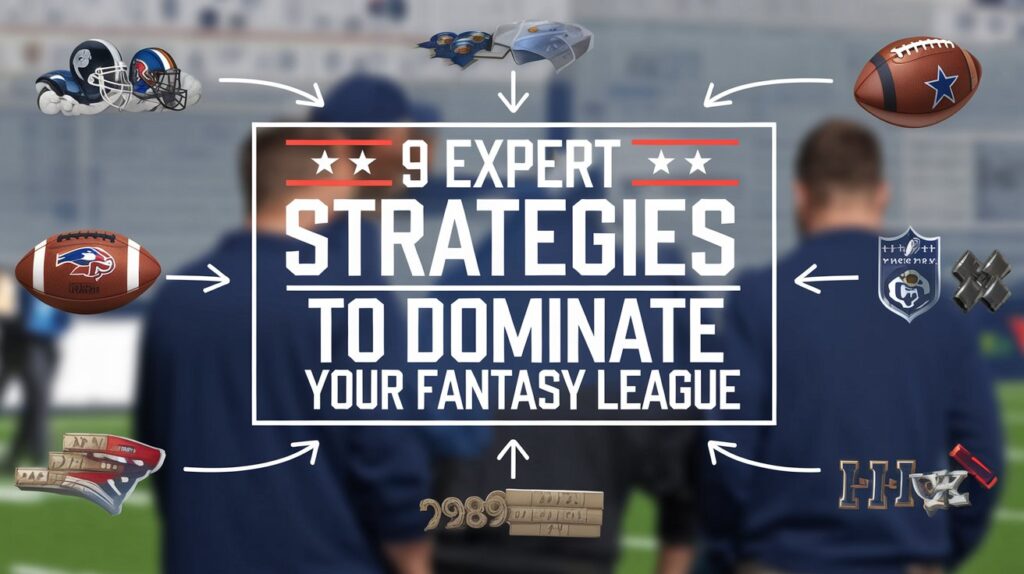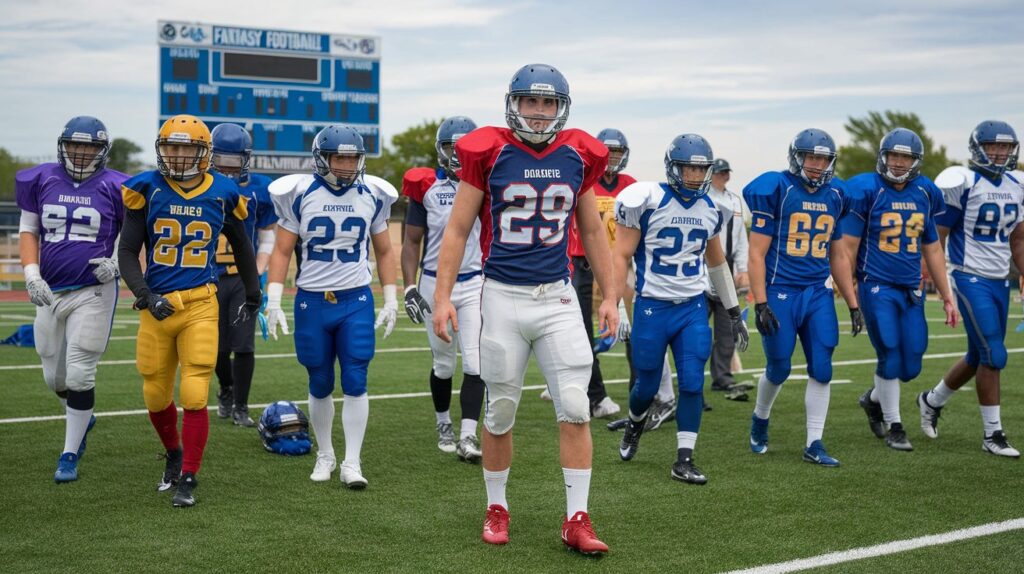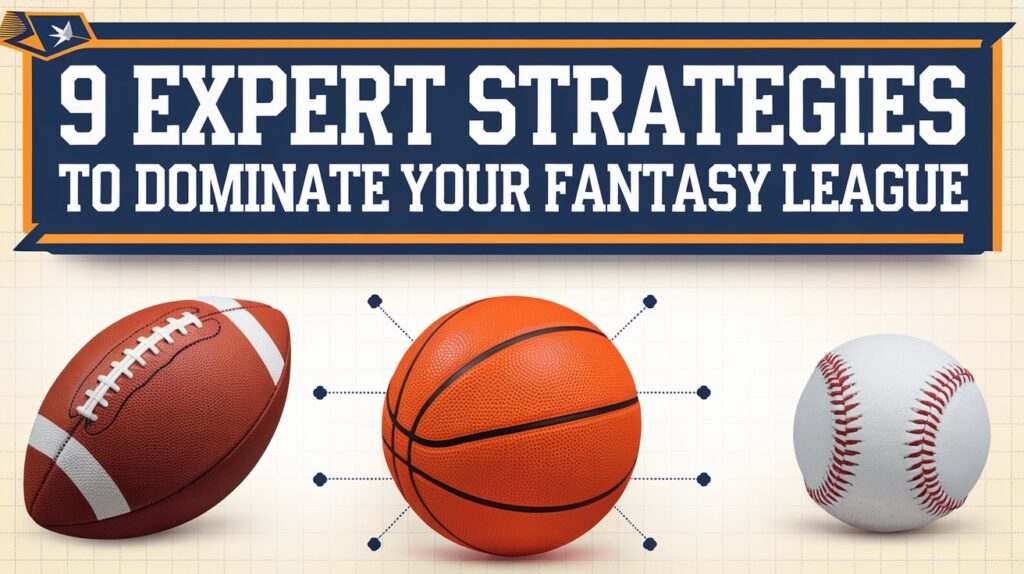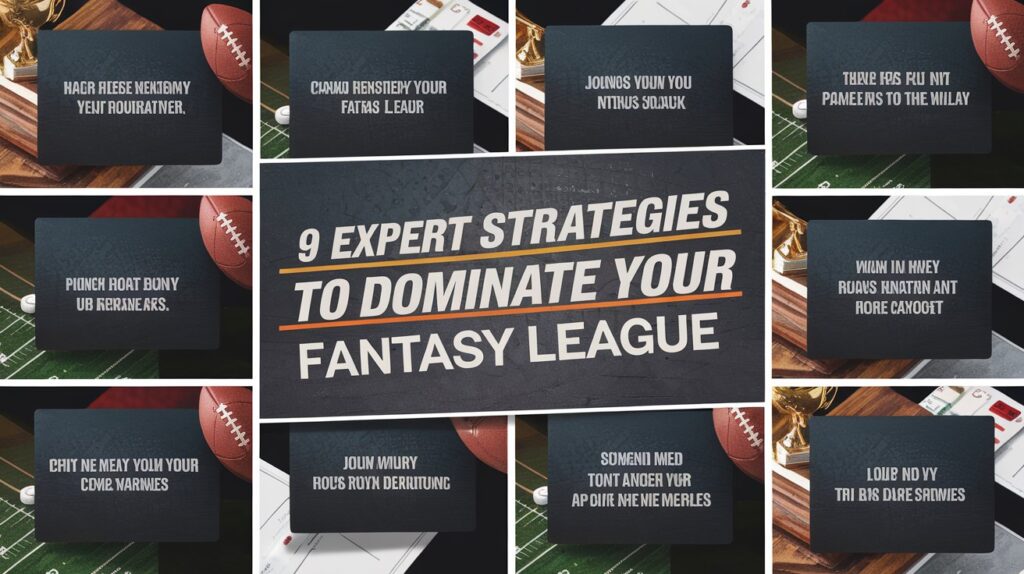Table of Contents

Introduction
Fantasy leagues are more than a game; they are a competitive strategy sport in which fans around the world enjoy the reality of being actual team managers.
Fantasy sports tips
From draft fantasy football teams in the UK, for instance, to constructing a hockey lineup in Canada, domination of any league takes much more than just knowledge-it takes strategic thinking. So today, we’re sharing nine time-tested tactics to keep you on top of your fantasy league.
Strategy 1: Begin With a Balancing Roster
a balancing roster can really well bear the heat of unexpected changes without breaking up. For example, instead of piling your team full of these high-scoring forwards, mix in some reliable defenders and backup players to bring in consistent points-not those picked in the first place.
Fantasy league strategies
My best fantasy experience was in early years, when I kept up my focus more on quarterbacks and wide receivers and left the running backs and the defensive players behind. I faltered in mid-season because my team failed, as I had no room for maneuvering if I got hurt. Hence, the lessons that I learned back then are so very significant, actually-in reality-the need for a balanced roster for long-term success.
Tip: Find some studs early and then focus on players that are going to give you real value in multiple scoring categories.

Strategy 2: Pay attention to injuries and lineups
maybe the most relevant information in any fantasy league, though, would be updates on injuries. Injuries can get pretty frustrating, but staying updated gives you a competitive advantage over everybody else. Players who keep track of injuries begin picking up backup players or benching under-performers at the right instance.
Fantasy league victory
As another user commented, “In fantasy basketball league, they vigilantly monitored every report of injuries and somehow picked an available point guard when one of the starters went down. It was a swift move that allowed them to gain all critical points in such a close match-up.”
Tip: You’re likely to come across other sports news apps similar to ESPN or BBC Sport and configure alerts so you know when to check their games. In all honesty, this would be particularly helpful especially with the injury-prone leagues of, for example, American football or European soccer.
Strategy 3. Learn as much as you can about your league’s scoring system
Other leagues differ very much, so you will find that knowing the scoring system you’re working with is very helpful in making informed decisions on roster picks. Some leagues place more emphasis on certain statistics, for example, passing yards or touchdowns for leagues within the USA and the NFL, whereas others score significantly more for clean sheets or assists for European soccer leagues.

Fantasy league player selection
Personal experience: one year I went all out for pure goal scorers in a league that offered bonuses for assists, and a trade partner outshot me until I switched my lineup to the high assist players. Know the bonus system for points in your league before applying your roster for that configuration.
Tip: Focus your attention on the players to whom it is most likely that points will be awarded in the largest numbers. The more you can learn about the rule of scoring, the more you are going to be able to play smarter than players who do not have the time or do not take the initiative to learn about such minute details.
Strategy # 4: Play bye weeks and match schedules to your advantage
a bye week occurs in weeks where the whole team does not play. You may sometimes catch managers off guard, as they are not aware of the change. If half of your marquee players are on a bye, you will still be trying to scramble to replace them.
Real-Life Application: One season, my friend learned the hard way to definitely have a bye week strategy. All of his top people were on bye for the playoffs one year. He did not plan for it at all, and his team really took a hit-and he lost the match.
Fantasy league tips and tricks
Tip: Keep track of each of your players bye weeks when you first obtain them; then, prepare for before their bye weeks. Apps, and also spreadsheets keep one aware of their respective schedules, but in leagues such as America’s NFL, some teams’ bye weeks impact many of the league’s better-playing players.
5 Use Waiver Wire and Free Agency
and this are a treasure trove of underrated talent, especially as the season unfolds and players really start popping. You’re going to see whether it’s the UK Football League or the USA Basketball League, which difference picking up the right and specific picks from the wire would give you that excellent edge.
For example, one paragraph of that article stated that the fantasy hockey player acquired a breakout player during mid-season via the waiver wire. That is the reason why his scoring was much better and he won for that league.
Tip: Clear out an hour from your week and go surfing through the waiver wire for some quality picks. Keep your eyes on whose numbers are increasing or filling a niche in the game as their clubs have suffered crucial injuries. In a hurry because the other managers must surely have noticed those quality picks.

Strategy 6: Trade Wits Aren’t Scared
Trading can be a pretty daunting thing, but sometimes you have to do it to control your fantasy league. Good trades are how you build up areas in your roster because you’re trading benchwarmers for stronger players or those who just fit better into your scoring system.
Personal Insight
i remember the years in which I played in my fantasy league longer and traded very seldom. First of all, it was usually good enough at the end of the season after I was long in running-or merely survived by then-but often I wasn’t too clever about those trades. Later on, I learned that if a trade was really well done then it could win or lose the ultimate prize in the end-winner.
Tip: Be very, very careful when making trade proposals. Look for win-win situations where both parties are better off. Trading is not to “win” a deal, but to make your team better overall.
Strategy 7: Research Player Stats and Trends devoutly
engage in player stats in order to know the things a casual manager might miss. Look at shooting percentages, yards per game, or tackles in your league.
Anecdote: Fantasy Soccer League:
It was the first time when a manager started noticing that one of his players was gaining far more assists per game by leaps and bounds. He held onto that player despite others saying trade him away, and increasing stats managed to push their final scores significantly.
Tip: Engage opt Sports and Pro Football Focus to take your presentation further, with more granular statistics. You may even find up-and-comers before they peak using trend following.
Strategy 8: Feed the Weather and Game Playing Conditions
For example, heavy rain, snow, or winds can be such influence in outdoor sports like soccer and American football. Weather conditions in sports could be quite different from one’s performance. For instance, heavy rain can limit passing in a game of football and enables your quarterback to score minimum points.
Well, I do recall some time back, I lost my chance due to not heeding the forecast of that day, which was a snow fall. Well, my player, kicker was having a very bad day hence a close game loss.
Tip: For weather-sensitive sports check out game day forecast. Apps such as AccuWeather have sport-specific forecasts to help you stay on point.
Dominate fantasy league
End
it is up to the fan to decide on his or her favorite or favorite team. Emotions, however, fog the picture and become pitfalls for poor decisions.
Anecdote: One fantasy football season, I hunted for my favorite players. I came into the draft room accompanied by my guy
my quarterback, my running back, and my wide receivers. Well, soon enough, I realized that they were not the best choices. Instead, I found out that nobody should allow emotions guide results and that selecting using data really works.
Tip: Establish performance expectations for each position. When a player is not meeting those, sit him or trade him, even if he is your favorite.

Conclusion
Master those and you will surely be well on your way to reigning supreme in your fantasy league. After all, just by analysis and strategy with a wee bit of luck at each play will do it. Fantasy leagues are not for the sake of winning, but to enjoy bringing your team to the championship winning status. We now enter the data and begin making smart moves up!
Fantasy league management
The outline of the article in every country makes readers feel connected through relatable stories, practical tips, and a global perspective about fantasy leagues. If you would like more in any section or country-specific advice, please let me know.
FAQs
1. How often should I check my fantasy league lineup?
Do it ideally every day or at least a few times a week. These are reminders, keeping you abreast of changes in the lineup, injuries, and available waiver wires.
2. When in fantasy leagues, should I trade?
One should probably trade early in the season so that one has a maximum chance of long-term success or do it close to the playoffs when one needs a last-minute fill-up.
3. What is waiver wire in fantasy leagues?
You can have your coach’s pick up waivers on a priority basis based on which players are unclaimed, usually every week, so plan your pickups wisely.
4. One star or spread my budget out?
Balance is best. Star players are very valuable, but too much reliance on one can be disastrous if he is injured or underperforms.
5. What is a sleeper pick?
A sleeper is simply that: a sleeper performance and potential can go beyond your wildest dreams. It might be about finding the point of breaking which differentiates one from gaining surprise points in any game by utilizing the potential the team possesses to create something worth